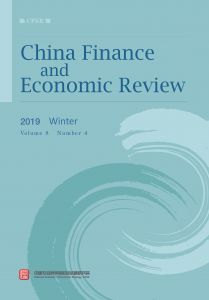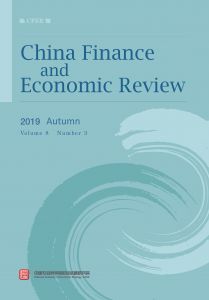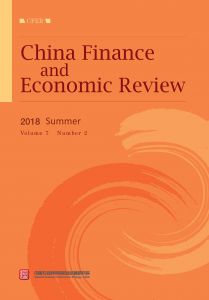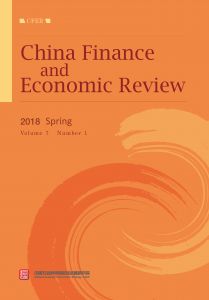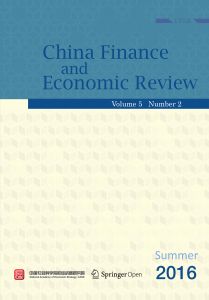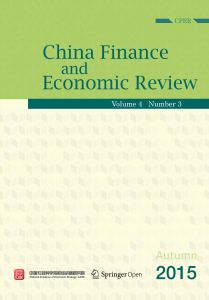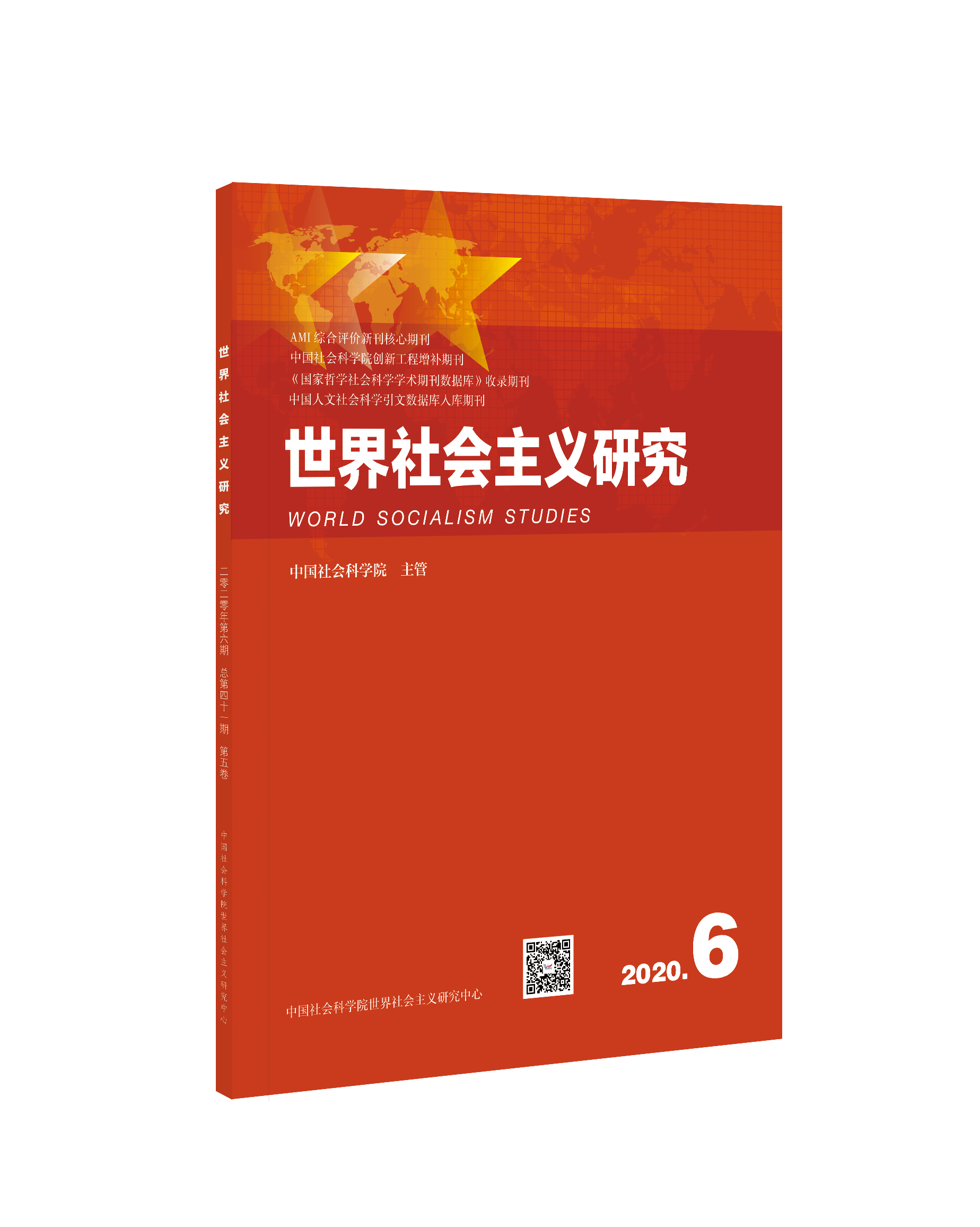最新期刊
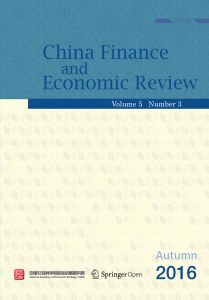
目录
过往期刊
参考文献
-
Instructions for Authors
-
编委会
-
Trilemma, RMB exchange rate regime reform, and policy orientation after August 2015
-
1. Introduction
-
2. The RMB exchange rate regime needs reform urgently
-
3. Trilemma faced by the large open economy and macroeconomic policy framework
-
4. Revisiting the traditional open macroeconomic and international finance theories
-
5. Policy implications
-
6. Conclusion
-
-
The impact of transfer payments on urban-rural income gap
-
1. Introduction
-
2. The theoretical analysis of transfer payment’s effect on income gap between urban and rural areas
-
3. Empirical model and data description
-
4. The regression results and analysis
-
5. Conclusions and policy recommendations
-
-
Risk identification, future value and credit capitalization: Research on the theory and policy of poverty alleviation by internet finance
-
1. Introduction
-
2. The current situation and problems of the existing mode of financial poverty alleviation
-
3. The theoretical basis of Internet financial assistance to poverty reduction: risk identification, future value and credit capitalization
-
4. The policy requirements for Internet finance in poverty reduction
-
-
Non-performing loans (NPLs), liquidity creation, and moral hazard: Case of Chinese banks
-
1. Introduction
-
2. Literature review
-
3. Data and methodology
-
4. Empirical findings
-
5. Conclusion
-
-
How does land finance effect economic growth in China?
-
1. Introduction
-
2. Literature review
-
3. Model
-
4. Empirical model and results
-
5. Conclusion
-
-
The impact of internet finance on commercial banks’ risk-taking: Theoretical interpretation and empirical test
-
1. Introduction
-
2. Theoretical model building
-
3. Design of empirical study
-
4. Empirical result study
-
5. Conclusion and political implications
-
-
Does Chinese OFDI really promote export?
-
1. Introduction
-
2. Conclusions and problems in the existing literature
-
3. Model setting, data description and estimation method
-
4. Empirical results and discussion
-
5. Conclusion and policy implications
-
按年份浏览:
- 全部
- 2020
- 2019
- 2018
- 2017
- 2016
- 2015
- 2014
- 2013
[1][1]Calvo, G. A., & Reinhart, C. M. (1982). Fear of floating. Quarterly Journal of Economics , 117 (2), 379-408.
[2][2]Chen, Y., & Wang, Y. (2007). Can China put the Tobin tax into effect? Taxation Research (Shuiwu Yanjiu) , 11, 11-15.
[3][3]Feng, M. (2015). Understanding the new normal of the RMB exchange rate. Tsinghua Financial Review , 2, 66-68.
[4][4]Fleming, J. M. (1962). Domestic financial policies under fixed and under floating exchange rates. IMF Staff Papers, 9 (3), 369-379.
[5][5]Galí, J., & Monacelli, T. (2005). Monetary policy and exchange rate volatility in a small open economy. The Review of Economic Studies , 72 (3), 707-734.
[6][6]Guan, T. (2011). The key to improve the RMB exchange rate formation mechanism: Overcoming the fear of floating. New Finance (Xin Jinrong) , 4, 9-12.
[7][7]Jeanne, O., Subramanian, A., & Williamson, J. (2012). Who needs to open the capital account. Peterson Institute working paper.
[8][8]Klein, M., Olivei, G. (2008). Capital account liberalization, financial depth, and economic growth. Journal of International Money and Finance , 27 (6), 861-875.
[9][9]Mckinnon, R., Ohno, K. (1997). Dollar and yen: Resolving economic conflict between the United States and Japan . MA: MIT Press.
[10][10]Mendoza, E. G. (1991). Real business cycles in a small open economy. American Economic Review , 81 (4), 797-818.
[11][11]Mundell, R. (1963). Capital mobility and stabilization policy under fixed and flexible exchange rates. Canadian Journal of Economic and Political Science , 29 (4), 475-485.
[12][12]Obstfeld, M. (2009). Time of troubles: The yen and Japan’s Economy, 1985-2008. NBER Working Paper No. 14816.
[13][13]Ostry, J., Ghosh, A., Habermeier, K., Chamon, M., Qureshi, M., & Reinhardt, D. (2010). Capital inflows: The role of controls. IMF staff position note, SPN/10/04.
[14][14]Patnaik, I., Shah, A. (2010). Asia confronts the impossible trinity. National Institute of Public Finance and Policy Working Paper 2010-64.
[15][15]Yi, G. (2000). The choice of exchange rate regime. Journal of Financial Research (Jinrong Yanjiu) , 9, 46-52.
[16][16]Yi, G. (2015). The direction of foreign exchange management reform and opening. China Finance (Zhongguo Jinrong) , 19, 18-20.
[17][17]Yi, G., & Tang, X. (2001). “Corner solutions” hypothesis of exchange rate regime: A theoretical foundation. Journal of Financial Research (Jinrong Yanjiu) , 8, 5-17.
[18][18]Yu, Y. (2015). Premature capital account opening commits a subversive error on fundamental issues. Economic Herald (Jingji Daobao) , 9, 11.
[19][19]Albouy, D.(2012). Evaluating the efficiency and equity of federal fiscal equalization. Journal of Public Economics , 96 (9-10), 824-839.
[20][20]Almond, D., Chen, Y., Greenstone, M., & Li, H. (2009) Winter heating or clean air? unintended impacts of China’s Huai river policy. American Economic Review , 99 (2), 184-190.
[21][21]Altonji, J., Elder, T., & Taber, C. (2005). Selection on observed and unobserved: Assessing the effectiveness of catholic schools. Journal of Political Economy , 113 (2), 151-184.
[22][22]Black, S. E.(1999). Do better schools matter? parental valuation of elementary education. Quarterly Journal of Economics , 114 (2), 577-599.
[23][23]Boadway R. (1982). On the method of taxation and the provision of local public goods: Comment. American Economic Review , 72 (4), 846-851.
[24][24]Boadway, R. & Shah, A. (2007). Intergovernmental fiscal transfers principles and practice . US: World Bank Publications.
[25][25]Dahlberg, M., Mörk, E., Rattsø, J., & Ågren, H. (2008). Using a discontinuous grant rule to identify the effect of grants on local taxes and spending, Journal of Public Economics , 92 (12), 2320-2335.
[26][26]Dell, M. (2010). The persistent effects of Peru’s mining mita. Econometrica , 78 (6), 1863-1903.
[27][27]Fu, W. l., & Shen, K. R. (2012). The equalization of transfer payment and local fiscal expenditure structure. Economic Research Journal (jingji Yanjiu) , 47 (5), 45-57.
[28][28]He, Q., & Dong, Z. Y. (2015). Transfer payment, local fiscal expenditure and residents’ happiness. Economic Perspectives (Jingjixue Dongtai) , 2, 56-65.
[29][29]Imbens, G. W., & Kalyanaraman, K. (2012). Optimal bandwidth choice for the regression discontinuity estimator. Review of Economic Studies , 79 (3), 933-959.
[30][30]Imbens, G. W., & Lemieux, T. (2008). Regression discontinuity designs: A guide to practice. Journal of Econometrics , 142 (2), 615-635.
[31][31]Keele, L. J., & Titiunik, R. (2014). Geographic boundaries as regression discontinuities. Political Analysis , mpu014.
[32][32]Lee, D. S., & Lemieux, T. (2010). Regression discontinuity designs in economics. Journal of Economic Literature , 48 (2), 281-355.
[33][33]Lei, G. Q., & Cai, X. (2012). Distortion of initial allocation, urban bias of fiscal expenditure and income gap between urban and rural—From the empirical evidence of provincial panel date in China. The Journal of quantitative & technical economics (Shuliang Jingji Yu Jishu Jingji Yanjiu) , 29 (3), 76-89.
[34][34]Liu, Q. Z. (2011). Income inequality and the decomposition of the redistribution function between central finance and local finance. Finance and Trade Economics (Caimao Jingji) , 5, 18-23.
[35][35]Lu, H. Y., & Chen, S. X. (2012). Who benefits from the added transfer payment—Based on the empirical analysis of China’s county-level data. Finance and Trade Economics (Caimao Jingji) , 4, 24-32.
[36][36]Meng, L. S. (2013). Evaluating China’s poverty alleviation program: A regression discontinuity approach. Journal of Public Economics , 101 (1), pp.1-11.
[37][37]Oates, W. E. (2005). Towards a second generation theory of fiscal federalism. International Tax and Public Finance , 12 (4), 349-373.
[38][38]Park, A., & Wang, S. (2010). Community-based development and poverty alleviation: An evaluation of China’s poor village investment program. Journal of Public Economics , 94 (7856), 790-799.
[39][39]Wagener, A. (2000). Variable population size issues in models of decentralized income redistribution. Regional Science and Urban Economics , 30 (6), 609-625.
[40][40]Wang, C., & Caminada, K. (2011). Disentangling income inequality and the redistributive effect of social transfers and taxes in 36 LIS countries. Department of Economics Research Memorandum , 4, 1-53.
[41][41]Yao, H. X., & Wang, X. Y. (2009). Labor flow, education level, poverty alleviation policy and income gap in rural—Based on the micro empirical research of multinomial logit model. Management World (Guanli Shijie) , 9, 80-90.
[42][42]Yin, H., & Zhu, H. (2011). Expenditure bias research on county level production. Social Sciences in China (Zhongguo Shehui Kexue) , 1, 88-101.
[43][43]Zeng, G., & Hu, J. J. (2009). Financial system of China’s urban bias and income gap between urban and rural residents. Public Finance Research (Caizheng Yanjiu) , 2, 36-39.
[44][44]Barabási, A. L. (2012). Bursts: new thinking to predict the future in the era of big data (translated by Ma Hui). China Renmin University press. (in Chinese)
[45][45]Bond, P. (2006). Criticism for Yunus, the Grameen and microfinance: A Nobel Prize usurer? 11.
[46][46]CGAP. (2003). Basic principles of microfinance . The Consultative Group to Assist the Poor of the World Bank, July.
[47][47]CGAP. (2014). Interest rate ceiling and microfinance . The Consultative Group to Assist the Poor of the World Bank, September.
[48][48]Gonzalez-Vega, C. (2003). Deepening Rural Financial Markets: Macroeconomic, Policy and Political Dimensions . Paving the Way Forward for Rural Finance An International Conference on Best Practices.
[49][49]Guo, X. M. (2008). Research on the financial system arrangement in county economic development . Doctoral Dissertation, Northwest Agriculture and Forestry University. (in Chinese)
[50][50]Li, H. F. (2012). A study on the theory and practice of rural finance development in China. Doctoral Dissertation, Jilin University, 24. (in Chinese)
[51][51]Lin, Y. N., & Xie, Z. Z. (2015). Look at county finance from the market share changes of county rural credit cooperatives. The Chinese Banker , 10, 118-121.
[52][52]Littlefield, E., Porteous, D., & Helms, B. (2015). Financial inclusion 2015: Four scenarios for the future of microfinance. World Bank.
[53][53]Liu, X. C., Huang, Z. H., & Cheng, E. J. (2007). Phenomenon description and theoretical explanation on the move up of micro credit objective: Based on the survey of farmers about the micro credit project in three provinces (regions). Chinese Rural Economy (Zhongguo Nongcun Jingji) , 8, 23-34.
[54][54]Lu, L. (2014). New proposition of rural financial reform. http://www.zgxcfx.com/Article/65210.html, March 5.
[55][55]World Bank. (2008). The report of World Bank. World Bank.
[56][56]Yan, H. B. (2015). Innovating “financial+” and implementing precise poverty alleviation: difficulties and countermeasures of China’s financial poverty alleviation. Wuhan Finance (Wuhan Jinrong) , 9, 56-59.
[57][57]Zero One Research Institute. (2016). Annual Report on Internet Crowd-funding in China (2015) . Zero One Research Institute, March. (in Chines)
[58][58]Zhang, W., & Hu, X. (2011). A review on the performance of 20 years’ subsidized loans for poverty alleviation in China. Journal of Yunnan University of Finance and Economics (Yunnan Caijing Daxue Xuebao) , 27 (1), 92-97.
[59][59]Zhangjiakou Sub Branch, the People’s Bank of China. (2015). Study on the model of financial poverty alleviation. Hebei Finance (Hebei Jinrong) , 6, 35-38.
[60][60]Arellano, M., & Bover, O. (1995). Another look at the instrumental variables estimation error components models. Journal of Econometrics , 68 (1), 29-51.
[61][61]Barseghyan, L. (2010). Non-performing loans, prospective bailouts, and Japan’s slowdown. Journal of Monetary Economics , 57 (7): 873-890.
[62][62]Beck, R., Jakubik, P., & Piloiu, A. (2015). Key determinants of non-performing loans: New evidence from a global sample. Open Economies Review , 156 (2):1-26.
[63][63]Berger, A. N., & Bouwman, C. H. S. (2009a). Bank liquidity creation. Review of Financial Studies , 22 (9) 3779-3837.
[64][64]Berger, A. N., & Bouwman, C. H. S. (2009b). Bank liquidity creation, monetary policy, and financial crisis. Working paper.
[65][65]Berger, A. N., Bouwman, C. H. S., Kick, T., & Schaeck, K. (2014). Bank risk taking and liquidity creation following regulatory interventions and capital support. Working paper.
[66][66]Berger, A. N., & Udell, G. F. (1994). Did risk based capital allocate bank credit and cause a “credit crunch” in the United States. Journal of Money, Credit and Banking , 26 (3), 585-628.
[67][67]Bernanke, B. S., & Gertler, M. (1989). Agency cost, net worth and business fluctuations. American Economic Review , 79 (1), 14-31.
[68][68]Berger, A. N., & DeYoung, R. (1997). Problem loans and cost efficiency in commercial banks. Journal of Banking & Finance , 21 (6), 849-870.
[69][69]BIS. (2006). Basel II: International convergence of capital measurement and capital Standards: A revised framework - comprehensive version. Basel: Basel Committee on Banking Supervision, Available at:<http://www.bis.org/publ/bcbs128.pdf>.
[70][70]Blundell, R., & Bond, S. (1998). Initial conditions and moment restrictions in dynamic panel data models. Journal of Econometrics , 87 (1), 15-143.
[71][71]Boudriga, A., Taktak, N. B., & Jellouli, S. (2010). Bank specific and institutional environment determinants of banks nonperforming loans: Evidence from MENA countries. Working paper.
[72][72]Boyd, J. H., & Prescott, E. E. (1986). Financial intermediary-coalitions. Journal of Economic Theory , 38 (2), 211-32.
[73][73]Bruche, M., & Llobet, G. (2011). Walking wounded or living dead? Making banks foreclose bad loans. Discussion paper No. 675.
[74][74]Bryant, J. (1980). A model of reserves, bank runs, and deposit insurance. Journal of Banking & Finance , 4 (4), 335-344.
[75][75]Chatterjee, U. K. (2015). Bank liquidity creation and asset market liquidity. Journal of Financial Stability , 18, 139-153.
[76][76]Deep, A.,& Schaefer, G. (2004). Are banks liquidity transformers. Working paper.
[77][77]Demsetz, R. S., Strahan, P. E. (1997). Diversification, size, and risk at bank holding companies. Journal of Money, Credit and Banking , 29 (3), 300-313.
[78][78]Dhar, S., & Bakshi, A. (2015). Determinants of loan losses of Indian banks: A panel study. Journal of Asia Business Studies , 9 (1), 17-32.
[79][79]Diamond, D. W. (1984). Financial intermediation and delegated monitoring. Review of Economic Studies , 51 (3), 393-414.
[80][80]Diamond, D. W., & Rajan, R. G. (2000). A theory of bank capital. Journal of Finance , 55 (6), 2431-2465.
[81][81]Diamond, D. W., & Rajan, R. G. (2001). Liquidity risk, liquidity creation, and financial fragility: A theory of banking. Journal of Political Economy , 109 (2), 287-327.
[82][82]Diamond, D. W., Dybvig, P. H. (1983). Bank runs, deposit insurance, and liquidity. Journal of Political Economy , 91 (3), 401-419.
[83][83]Distinguin, I., Roulet, C., & Tarazi, A. (2013). Bank regulatory capital and liquidity: Evidence from US and European publically traded banks. Journal of Banking & Finance , 37 (9), 3295-3317.
[84][84]Espinoza, R., & Prasad, A. (2010). Nonperforming loans in the GCC banking system and their macroeconomic effects. Working paper.
[85][85]Foos, D., Norden, L., & Weber, M. (2010). Loan growth and riskiness of banks. Journal of Banking & Finance , 34 (2), 2929-2940.
[86][86]Ghosh, A. (2015). Banking-industry specific and regional economic determinants of non-performing loans: Evidence from US states. Journal of Financial Stability , 20, 93-104.
[87][87]Gonzales-Hermosillo, B. (1999). Developing indicators to provide early warnings of banking crises. Financial Development , 36 (2), 36-39.
[88][88]Gorton, G., & Rosen, R. (1995). Corporate control, portfolio choice, and the decline of banking. The Journal of Finance , 50 (5), 1377-1420.
[89][89]Gorton, G., & Winton, A. (2000). Liquidity provision, bank capital, and the macro economy. Working paper.
[90][90]Hackethal, A., Rauch, C., Steffen, S., Tyrell, M. (2010). Determinants of bank liquidity creation. Working paper.
[91][91]Hellmann, T. F., Murdock, K. C., & Stiglitz, J. E. (2000). Liberation, moral hazard in banking, and prudential regulations: Are capital requirements enough? The American Economic Review , 90 (1), 147-165.
[92][92]Holmstrom, B., & Tirole, J. (1998). Public and private supply of liquidity. Journal of Political Economy , 106 (1), 1-40.
[93][93]Horvath, R., Seidler, J., & Weill, L. (2014). Bank capital and liquidity creation: Granger-causality evidence. Journal of Financial Services Research , 45 (3), 341-361.
[94][94]Imbierowicz, B., & Rauch, C. (2014). The relationship between liquidity risk and credit risk in banks. Journal of Banking & Finance , 40 (1), 242-256.
[95][95]IMF. (2006). The financial soundness indicators compilation guide of March 2006. Available at:<http://www.imf.org/external/pubs/ft/fsi/guide/2006/>.
[96][96]Jensen, M. C., & Meckling, W. H. (1976). Theory of the Firm: managerial behavior, agency costs and ownership structure. Journal of Financial Economics , 3 (4), 305-360.
[97][97]Kashyap, A. K., Rajan, R. G., & Stein. J. C. (2002). Banks as liquidity providers: An explanation for the coexistance of lending and deposit taking. Journal of Finance , 57 (1), 591-629.
[98][98]Keeley, M. C. (1990). Deposit insurance, risk, and market power in banking. American Economic Review , 80 (5), 1183-1200.
[99][99]Kiyotaki, N., & Moore, J. (1997). Credit cycles. Journal of Political Economy , 105 (2), 211-248.
[100][100]Klein, N. (2013). Non-performing loans in CESEE: Determinants and impact on macroeconomic performance. Working Paper.
[101][101]Koudstaal, M., & Wijnbergen, S. V. (2012). On risk, leverage and banks: Do highly leveraged banks take on excessive risk? Working paper.
[102][102]Lawrence, C. E. (1995). Consumer default and the life cycle model. Journal of Money Credit and Banking , 27 (4), 939-954.
[103][103]Lei, A.C. H., & Song, Z. (2013). Liquidity creation and bank capital structure in China. Global Finance Journal , 24 (3), 188-202.
[104][104]Louzis, D. P., Vouldis, A. T., & Metaxas, V. L. (2012). Macroeconomic and bank-specific determinants of non-performing loans in Greece: A comparative study of mortgage, business and consumer loan portfolios. Journal of Banking & Finance , 36 (4), 1012-1027.
[105][105]Lu, D., Thangavelu, M., & Hu, Q. (2007). Biased lending and non-performing loans in China’s banking sector. The Journal of Development Studies , 41 (6), 1071-1091.
[106][106]Luo, D., & Ying, Q. (2014). Political connections and bank lines of credit. Emerging Markets Finance and Trade , 50 (s3), 5-21.
[107][107]Mclever, R. (2005). Asset management companies, state-owned commercial bank debt transfers and contingent claims: Issues in the valuation of China’s non-performing loans. Managerial Finance , 31 (12), 11-28.
[108][108]Moenninghoff, S. C., Ongena, S., & Wieandt, A. (2015). The perennial challenge to counter too-big-to-fail in banking: Empirical evidence from the new international regulation dealing with global systematically important banks. Journal of Banking & Finance , 61, 221-236.
[109][109]Nier, E., & Bouwmann, U. (2006). Market discipline, disclosure, and moral hazard in banking. Journal of Financial Intermediation , 15 (3), 332-361.
[110][110]Nkusu, M. (2011). Nonperforming loans and macro financial vulnerabilities in advanced economies. Working Paper.
[111][111]Repullo, R. (2004). Capital requirements, market power, and risk taking in banking. Journal of Financial Intermediation , 13 (2), 156-182.
[112][112]Saunders, A., Strock, E., & Travlos, N. G. (1990). Ownership structure, deregulation, and bank risk taking. The Journal of Finance , 45 (45), 643-654.
[113][113]Shrieves, R. E., & Dahl, D. (2003). Discretionary accounting and the behavior of Japanese banks under financial duress. Journal of Banking & Finance , 27 (7), 1219-1243.
[114][114]Skarica, B. (2014). Determinants of non-performing loans in Central and Eastern European countries. Financial Theory and Practice, 38 (1), 37-59.
[115][115]Suzuki, Y., Mian, Md. D, & Yuan, J. (2008). China’s non-performing bank loan crisis: the role of economic rents. Asian-Pacific Economic Literature , 22 (1), 57-70.
[116][116]Tanasković, S., & Jandrić, M. (2015). Macroeconomic and institutional determinants of non-performing loans. Journal of Central Banking Theory and Practice , 4 (1), 47-62.
[117][117]Von Thadden, E.-L. (2004). Bank capital adequacy regulation under new Basel accord. Journal of Financial Intermediation , 13 (2), 90-95.
[118][118]Zeng, S. (2012). Bank non-performing loans (NPLs): A dynamic model and analysis in China. Modern Economy , 3 (1), 100-110.
[119][119]Zhang, D., Ca, i.J., Dickinson, D. G., & Kutan, A. M. (2015). Non-performing loans, moral hazard and regulation of Chinese commercial banking system. Journal of Banking & Finance , 63 (5), 48-60.
[120][120]Zhou, K. (2014). The effect of income diversification on bank risk: Evidence from China. Emerging Markets Finance and Trade, 50 (s3), 201-2013.
[121][121]Zhu, N., Wang, B., & Wu, Y. (2014). Productivity, efficiency, and non-performing loans in the Chinese banking industry. The Social Science Journal , 52 (4), 468-480.
[122][122]Cobb, C., & Douglas, P. (1928). A theory of production. The American Economic Review, 18 (1), 139-165.
[123][123]Deng, X., Huang, J., Rozelle, S., & Uchida, E. (2010). Economic growth and the expansion of urban land in China. Urban Studies, 47 (4), 813-843.
[124][124]Ding, C., & Lichtenberg, E. (2011). Land and urban economic growth in China. Journal of Regional Science, 51 (2), 299-317.
[125][125]Du, X. J., Huang, Z. H., & Wu, C. F (2009). Land finance and economic growth in China--Analysis based on provincial panel data. Finance & Trade Economies (Caimao Jingji) , 1, 60-64
[126][126]Feng, L., Wei, L., & Jiang, Y. (2008). Study on the contribution of land element to economic growth in China. China Land Science (Zhongguo Tudi Kexue), 22 (12), 4-10.
[127][127]Gong, R. K. (2012). Tax-share reform, fiscal decentralization and housing price. Economic Theory and Business Management (Jingji Lilun Yu Jingji Guanli) , 4, 45-56.
[128][128]Hansen, G., & Prescott, E. (2001). Malthus to Solow. The American Economic Review , 92 (4), 1205-1217.
[129][129]Harvey, J., & Jowsey, E. (2004). Urban land economics (6th edition), Palgrave MacMillan.
[130][130]Homburg, S. (1991). Interest and growth in an economy with Land. The Canadian Journal of Economics , 24 (2), 450-459.
[131][131]Jiang. X. S., Liu, S. Y., & Li, Q. (2007). The land reform and economic growth. Management World (Guanli Shijie) , 9, 1-9.
[132][132]Jiang, Z. (2014). Industrialization, local government efforts and land finance: A perspective of land finance in China. China Industrial Economics (Zhongguo Gongye Jingji), 319 (10), 33-45.
[133][133]Li, H., Yin, F., & Li, J. (2008). China’s construction land expansion and economic growth: A capital-output ratio based analysis. China & World Economy , 16 (6), 1-17.
[134][134]Lichtenberg, E., & Ding, C. (2009). Land officials as land developers: Urban spatial expansion in China. Journal of Urban Economics, 66 , 57-64.
[135][135]Liu, J., Wu, J. N., & Ma, L. (2012). Local officials’ promotion and land finance in China: An empirical analysis of panel data from municipal-level cities. Journal of Public Management (Gonggong Guanli Xuebao) , 9 (2), 11-23.
[136][136]Liu, X. G., Zhang, X., & Fang, W. Q. (2015). The income allocation of infrastructure between rural area and urban area: A perspective from labor transfer. The Journal of World Economy (Shijie Jingji) , 3, 145-170.
[137][137]Loupias, C., & Wigniolle, B. (2013). Population, land and growth. Economic Modeling , 31, 223-237.
[138][138]McCain, R. (1970). Land in Fellner’s model of economic growth: Comment. The American Economic Review, 60 (3), 495-499.
[139][139]Metzemakers, P., & Louw, E. (2005). Land as a production factor. Paper to be presented on 45th Congress of the European Regional Science Association in Amsterdam, 23-27.
[140][140]Ngai, R. (2004). Barriers and the transition to modern growth. Journal of Monetary Economics , 51 (7), 1353-1383.
[141][141]Nichols, D. (1970). Land and economic growth. The American Economic Review, 60 (3), 332-340.
[142][142]Research Group on China’s Economic Growth (CASS). (2011). Urbanization, fiscal expansion and economic growth, Economic Research Journal (Jingji Yanjiu), 46 (11), 4-20.
[143][143]Rhee, C. (1991). Dynamic inefficiency in an economy with land. Review of Economic Studies , 58 (4), 791-797.
[144][144]Solow, R. (1974). Intergenerational equity and exhaustible resources. The Review of Economic Studies, 41 , 29-45.
[145][145]Sun, X. L., & Zhou, F. Z. (2013). Land finance and the tax-sharing system: An empirical explanation. Social Sciences in China (Zhongguo Shehui Kexue) , 4, 40-59.
[146][146]Wu, Y., Zhang, X., Skitmore, M., Song, Y., & Hui, E. (2014). Industrial land price and its impact on urban growth: A Chinese case study. Land Use Policy , 36, 199-209.
[147][147]Xue, B., & Chi, X. (2010). Land finance, rent-seeking and economic growth. Public Finance Research (Caizheng Yanjiu) , 2, 27-30.
[148][148]Ye, J. P., Ma, C. F., & Zhang, Q. H. (2011). The analysis on the contribution of land to economic growth in China: Based on spatial panel data. Finance & Trade Economies (Caimao Jingji) , 4, 15-23.
[149][149]Yu, J. W., Xiao, J., & Gong, L. T. (2015). Political cycle and land leasing: Evidence from Chinese cities. Economic Research Journal (Jingji Yanjiu), 50 (2), 88-102.
[150][150]Zou, W., & Liu, H. Y. (2015). Land finance in China: an empirical analysis of spatial panel data from municipal-level cities. Economist (Jingji Xuejia) , 9, 21-32.
[151][151]Allen, F., & Gale, D. (2000). Financial contagion. Journal of Political Economy , 108 (1), 1-33.
[152][152]Arellano, M., & Bond, S. (2004). Some tests of specification for panel date: Monte carlo evidence and an application to employment equations. Review of Economics Studies , 58 (2), 277-297.
[153][153]Ariss, R. (2010). On the implications of market power in banking: Evidence from developing countries. Journal of Banking and Finance , 34 (4), 765-775.
[154][154]Askitas, N., & Zimmermann, K. F. (2009). Google econometrics and unemployment Forecasting. Applied Economics Quarterly , 55 (2), 107-120.
[155][155]Beltratti, A., & Stultz, R. M. (2012). The credit crisis around the globe: Why did some banks perform better? Journal of Financial Economics , 105 (1), 2012, 1-17.
[156][156]Berger, A. N., Klapper, L. F., & Turk-Ariss, R. (2009). Bank competition and financial stability. Journal of Financial Services Research , 35 (2), 99-118.
[157][157]Blundell, R., & Bond, S. (1998). Initial conditions and moment restrictions in dynamic panel data models. Journal of Econometrics , 87 (1), 115-143.
[158][158]Chen, Z. W. (2014). How fresh is the internet finance. New Finance (Xin Jinrong) , 4, 9-13.
[159][159]Dai, G. Q., & Fang, P. F. (2014). Supervision innovation, interest rate liberation and internet finance. Modern Economic Research (Xiandai Jingji Tansuo) , 7, 64-82.
[160][160]Delis, M. D., & Kouretas G. P. (2011). Interest rates and bank risk-taking. Journal of Banking and Finance , 35 (4), 840-855.
[161][161]Gao, Z. X., Li, C., & L, S. F. (2015). The coordination between monetary policy and prudential supervision. Modern Economic Science (Dangdai Jingji Kexue) , 37 (1), 56-66.
[162][162]He, D., & Wang, H. (2012). Dual-track interest rates and the conduct of monetary policy in China. China Economic Review , 23 (4), 928-947.
[163][163]Hellmann, T. F., Murdock, K. C., & Stiglitz, J. E. (2000). Liberalization, moral hazard in banking, and prudential regulation: Are capital requirements enough? American Economic Review , 90 (1) 147-165.
[164][164]Jimenez, G., Lopez, J. A., & Saurina, J. (2013). How does competition affect bank risk taking? Journal of Financial Stability , 9 (2), 185-195.
[165][165]Kishan, R. P., & Opiela, T. P. (2000). Bank size, bank capital, and the bank lending channel. Journal of Money, Credit and Banking , 32 (1), 121-142.
[166][166]Liu, H. E., & Shi, W. G. (2015). The focus and conflict in theory of internet finance. Economist (Jingji Xuejia) , 5, 60-67.
[167][167]Liu, L. Y., Li, M. H., Sun, S. & Yang, J. Q. (2014). The relationship between net interest margin and non-interest income for Chinese banks. Economic Research Journal (Jingji Yanjiu) , 49 (7), 110-123.
[168][168]Liu, Z. Y., & Huang, K. H. (2015). Tirole’s Theory and the regulation of China’s internet finance. Comparative Economic and Social Systems (Jingji Shehui Tizhi Bijiao) , 2, 64-76.
[169][169]López, M., Tenjo, F., & Zárate, H. (2011). The risk-taking channel and monetary transmission mechanism in Colombia. Ensayos Sobre Politica Economica , 29(616), 212-234.
[170][170]Mckinnon, R. I. (1973). Money and capital in economic development , Washington: The Brookings Institution.
[171][171]Merton, R. C., & Bodie, Z. (1995). A conceptual framework for analyzing the financial environment . Cambridge: Harvard Business School Press.
[172][172]Mulherin, J. H., & Boone, A. L. (2000). Comparing acquisitions and divestitures. Journal of Corporate Finance , 6 (6), 117-139.
[173][173]Mussa, A. S. (2010). Asymmetric bank risk taking and monetary policy. http://homepages.wmich.edu/~a6mussa/documents/Asymmetric% 20Bank%20Risk.pdf.
[174][174]Nautz D., & Scheithauer, J. (2011). Monetary policy implementation and overnight rate persistence. Journal of International Money and Finance , 30 (7), 1375-1386.
[175][175]Nautz, D., & Schmidt, S. (2009). Monetary policy implementation and the federal funds rate. Journal of Banking and Finance , 33 (7), 1274-1284.
[176][176]Repullo, R. (2004). Capital Requirements, Market power, and risk-taking in banking. Journal of Financial Intermediation , 13 (2), 156-182.
[177][177]Shahrokhi, M. (2008). E-finance: Status, Innovations, resources and future challenges. Managerial Finance , 34 (6), 365-398.
[178][178]Shaw S. E. (1973). Financial deepening in economic development , New York: Oxford University Press.
[179][179]Shen, Y., & Guo, Pin. (2015). Internet finance, technology spillover and commercial banks TFP. Journal of Financial Research (Jinrong Yanjiu) , 3, 160-175.
[180][180]Syed, A. R., & Nida, H. (2013). Factors affecting internet banking adoption among internal and external customers: A case of Pakistan. Journal of Electronic Finance , 7 (1), 82-96.
[181][181]Wang, G. G., & Zhang, Y. (2015). A critique of internet finance. Finance and Trade Economies (Caimao Jingji) , 1, 5-16.
[182][182]Wang, S. J., & Peng, J. G. (2014). The studies on the measurement and performance of China’s interest rate liberation: Empirical analysis based on the bank credit channel. Journal of Finance and Economics (Jinrong Jingjixue Yanjiu) , 29 (11), 75-85.
[183][183]Wang, X., & Johansson, A. (2013). Financial Repression and Structural Transformation. Economic Research Journal (Jingji Yanjiu) , 48 (1), 54-66.
[184][184]Wang, Y. C. (2014). Financial repression and credit redistribution. Economic Research Journal (Jingji Yanjiu) , 49 (6), 86-98.
[185][185]Wang, Y. Q., & Jin, H. F. (2014). Interest rate liberation, price competition and bank risk taking. Economic Management Journal (Jingji Guanli) , 36 (5), 93-102.
[186][186]Wu, J. L. (1997). Two Issues in the Formation of China’s Financial Market: Financial Repression and Economic Bubbles. Comparative Economic and Social Systems (Jingji Shehui Tizhi Bijiao) , 2, 2-5.
[187][187]Wu, X. Q. (2015). Internet finance: the logic of growth. Finance and Trade Economics (Caimao Jingji) , 2, 5-15.
[188][188]Xie, P., & Zou, C. W. (2012). Study on the internet finance mode. Journal of Financial Research (Jinrong Yanjiu) , 12, 11-22.
[189][189]Yao, S. J., Jiang, C. X., & Feng, G. F. (2011). Banking reform and efficiency in China: 1995—2008. Economic Research Journal (Jingji Yanjiu) , 46 (8), 4-13.
[190][190]Zheng, L. S. (2014). China’s internet finance: model, impact, nature and risks. International Economic Review (Guoji Jingji Pinglun) , 5, 103-118.
[191][191]Zheng, Z. L. (2015). The influence of internet finance of commercial banks—based on the perspective of the influence of “internet +” on the retail industry, Finance and Economics (Caijing Kexue) , 5, 34-43.
[192][192]Anderson, J. E. (1979). A theoretical foundation for the gravity equation. American Economic Review , 69 (1), 106-116.
[193][193]Anderson, J. E., & van Wincoop, E. (2004). Trade costs. Journal of Economic Literature , 42 (3), 691-751.
[194][194]Belderbos, R., & Sleuwaegen, L. (1998). Tariff jumping DFI and export substitution: Japanese electronics firms in Europe. International Journal of Industrial Organization , 16 , (5), 601-638.
[195][195]Bergstrand, J. H. (1985). The gravity equation in international trade: Some microeconomic foundations and empirical evidence. Review of Economics and Statistics , 67 (3), 474-481.
[196][196]Buckley, P. J., & Casson, M. (1981). The optimal timing of a foreign direct investment. The Economic Journal , 91 (361), 75-87.
[197][197]Cai, R., & Liu, Q. (2004). Are the Chinese international direct investment and trade complementary? — The empirical analysis based on the marginal industry theory. World Economy Study (Shijie Jingji Yanjiu) , 8, 64-70.
[198][198]Chen, L. M., Yang, Z., & Hou, Z. P. (2010). Export driven or export substitution? — The marginal industry strategy test of Chinese OFDI. Finance & Trade Economics (Caimao Jingji) , 2, 78-85.
[199][199]Chen, W., & Tang, H. (2014). The dragon is flying west: Micro-level evidence of Chinese outward direct investment. Asian Development Review , 31 (2), 109-140.
[200][200]Hao, J. F., & Ma, H. (2012). The new development of gravity model and the test of Chinese foreign trade. The Journal of Quantitative & Technical Economics (Shuliang Jingji Jishu Jingji Yanjiu) , 29 (10), 52-68.
[201][201]Head, K., & Ries, J. (2001). Overseas investment and firm exports. Review of International Economics , 9 (1), 108-122.
[202][202]Helpman, E. (1984). A simple theory of international trade with multinational corporations. Journal of Political Economy , 92 (3), 451-471.
[203][203]Helpman, E., Melitz, M. J., & Yeaple, S. R. (2004). Export versus OFDI with heterogeneous firms. American Economic Rev iew, 94 (1), 300-316.
[204][204]Hirsch, S. (1976). An international trade and investment theory of the firm. Oxford Economic Papers , 28 (2), 258-270.
[205][205]Horst, T. (1972). Firm and industry determinants of the decision to invest abroad: an empirical study. Review of Economics and Statistics , 54 (3), 258-266.
[206][206]Hu, B., & Qiao, J. (2013). The trade effect of China’s OFDI—Based on dynamic panel model system GMM method. Economic Management (Jingji Guanli) , 35 (4), 11-19.
[207][207]Jiang, G.H., & Jiang, D. C.(2014). Export effect of Chinese OFDI. Economic Research Journal (Jingji Yanjiu) , 49 (5), 160-173.
[208][208]Kojima, K. (1975). International trade and foreign investment: Substitutes or complements. Hitotsubashi Journal of Economics , 16 (1), 1-12.
[209][209]Lin, C. F., & Dong, Q. (2013). The export effect of Chinese OFDI: Inhibition or promotion -- based on the empirical study of panel data of 21 countries. Industrial Economic Review (Chanye Jingji Pinglun) , 4 (5), 152-160.
[210][210]Lipsey, R. E., & Weiss, M. Y. (1981). Foreign production and exports in manufacturing industries. Review of Economics and Statistics , 63 (4), 488-494.
[211][211]Lipsey, R. E., & Weiss, M. Y. (1984). Foreign production and exports of individual firms. Review of Economics and Statistics , 66 (2), 304-308.
[212][212]Liu, H. Y., & Nie, F.(2014). Hollow effect of Chinese OFDI of manufacturing industry. China Industrial Economics (Zhongguo Gongye Jingji) , 4, 83-96.
[213][213]Liu, X. G., Gou, Q., & Lu, F. (2014). The impact analysis of Chinese OFDI on export. working paper of economic research, WP672.
[214][214]Liu, Z. Q., & Xie, R. D. (2014). The empirical analysis of country effect of Chinese OFDI on ASEAN. World Economic Studies (Shijie Jingji Yanjiu) ,, 6 80-86.
[215][215]Mao, Q. l., & Xu, J. U. (2014). Does Chinese OFDI promote or inhibit the enterprise export. Journal of Quantitative & Technical Economics (Shuliang Jingji Jishu Jingji Yanjiu) , 31 (9), 3-21.
[216][216]Mundell, R. A. (1957). International Trade and Factor Mobility. American Economic Review , 47 (3), 321-335.
[217][217]Oberhofer, H., & Pfaffermayr, M. (2012). OFDI versus exports: multiple host countries and empirical evidence. The World Economy , 35 (3), 316-330.
[218][218]Qiao, J., & Hu, B. (2015). How OFDI affect export—Based on the matching of manufacturing enterprises. Journal of International Trade (Guoji Maoji Wenti) , 4, 126-136.
[219][219]Schmitz, A., & Helmberger, P. (1970). Factor mobility and international trade: the case of complementarity. American Economic Review , 60 (4), 761-767.
[220][220]Silva, S., & Tenreyro, S. (2006). The log of gravity. The Review of Economics and Statistics , 88 (4), 641-658.
[221][221]Tinbergen, J. (1962). An analysis of world trade flows in shaping the world economy . New York: Twentieth Century Fund.
[222][222]Vernon, R. (1966). International Investment and International Trade in the Product Cycle. Quarterly Journal of Economics , 80 (2), 190-207.
[223][223]Wang, B. J. (2013). The misunderstood official data—the real OFDI of China”, International Economic Review (Guoji Jingji Pinglun) , 1, 61-74.
[224][224]Wang, S. l., & Xiang, J. J. (2014). Creation or substitution—the mechanism research of Chinese OFDI on trade. World Economy Studies (Shijie Jingji Yanjiu) , 6.
[225][225]Wang, S., Tian, T., & Xie, R. D. (2014).The trade effect research of Chinese OFDI. World Economy Studies (Shijie Jingji Yanjiu) , 10, 80-86.
[226][226]Xiang, B. W. (2009). The trade effect research of Chinese OFDI—Based on the co-integration analysis of panel data. Finance & Trade Economics (Caimao Jingji) , 4, 77-82.
[227][227]Zhang, C. P. (2012). The trade effect research of OFDI. Journal of Quantitative & Technical Economics (Shuliang Jingji Jishu Jingji Yanjiu) , 29 (6), 74-85.
[228][228]Zhang, J. F., & Huang, P. (2013). Replacement of exports or promoting exports—the research on the effect of OFDI on export. Journal of International Trade (Guoji Maoji Wenti) , 3, 95-103.
[229][229]Zhang, R. Q. (2005). The analysis of the relationship between OFDI and international trade. World Economic Studies (Shijie Jingji Yanjiu) , 3, 23-27.
[230][230]Zhang, Y. W. (2007). The relationship between OFDI and trade: Complementary or alternative. Journal of International Trade (Guoji Maoji Wenti) , 6, 87-93.
[231][231]Zhou, X., & Niu, R. (2012). Chinese OFDI and the trade effect—Based on the empirical research on panel gravity model. International Economics and Trade Research (Guoji Jingmao Tansuo) , 5, 69-81.
[展开]
相关推荐
手机可扫码阅读




